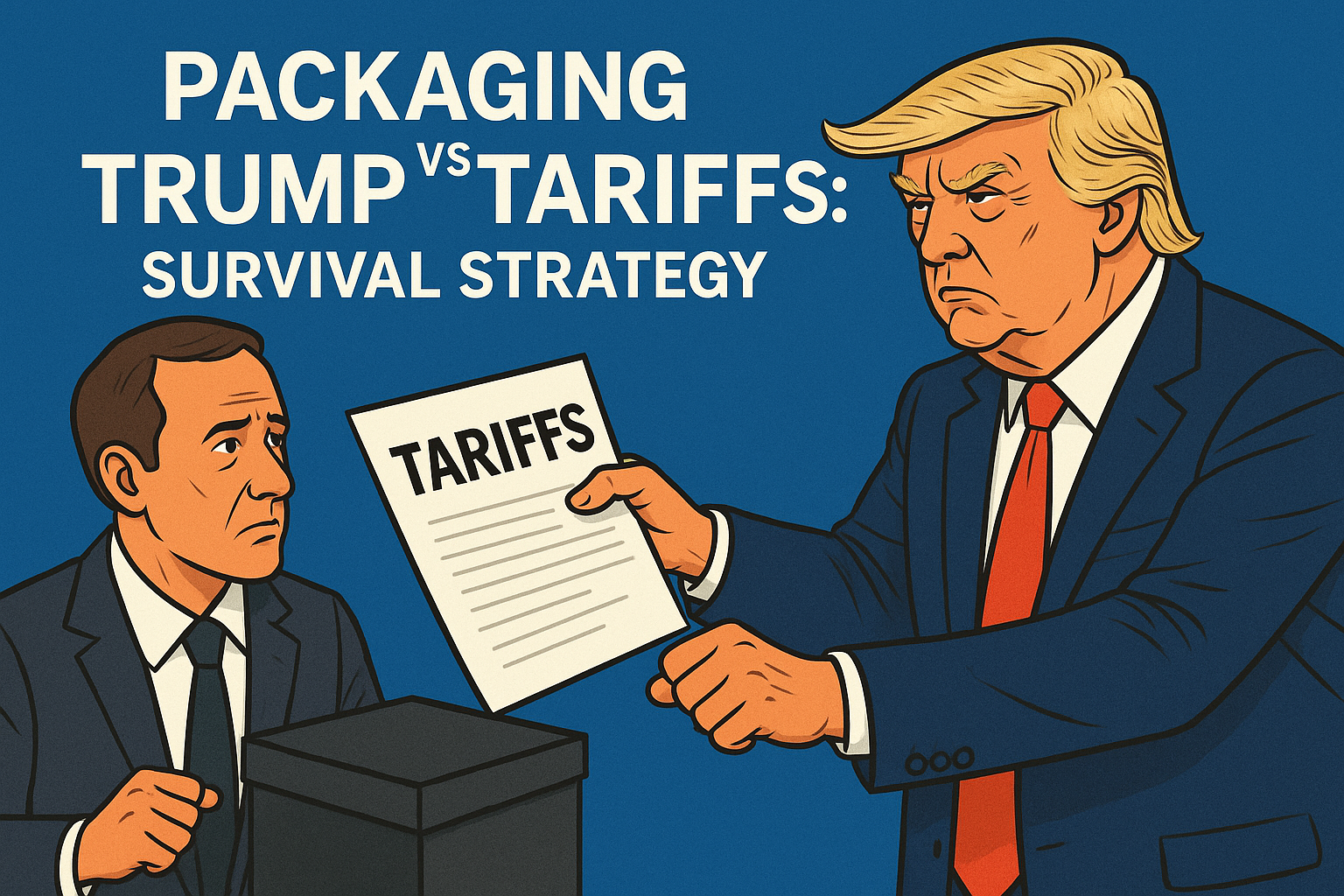The packaging industry has been significantly impacted by the imposition of Trump’s tariffs. As these tariffs have triggered a chain reaction in the supply chain, many businesses are left to grapple with higher material costs, disrupted operations, and uncertain economic forecasts. In this article, we will explore how the packaging industry is coping with these challenges, how businesses are adjusting their strategies, and what the future might hold for packaging manufacturers. Let’s dive in and explore how companies can survive and even thrive despite the hurdles posed by these tariffs.
1. How have Trump tariffs impacted the packaging industry?
The Trump administration’s tariffs introduced a wave of challenges to industries across the globe, with the packaging industry being no exception. These tariffs increased the cost of raw materials, particularly metals and plastics, which are essential in packaging production. But here’s the kicker—the tariffs didn’t just impact the cost of materials, they also created major disruptions in the supply chain. Importers faced delays, and companies that relied on overseas suppliers were left scrambling to find alternative sources for their materials.
In addition to higher material costs, the tariffs also led to inflated prices for machinery and equipment needed for production. This, in turn, forced many packaging companies to either delay investments or reduce their overall production capacity. It’s simple—these economic factors didn’t just increase costs; they created uncertainty, making long-term forecasting nearly impossible for packaging firms.
Moreover, tariffs have affected the competitive landscape, with companies that rely on international suppliers finding themselves at a disadvantage compared to those who source locally. As a result, many businesses are now reevaluating their procurement strategies and considering reshoring or diversifying their suppliers.
Table 1: Impact of Trump Tariffs on Key Packaging Materials
| Material | Cost Increase | Supply Chain Disruption | Alternatives |
|---|---|---|---|
| Metals (Aluminum, Steel) | 15-20% | High delays | Domestic suppliers, recycling |
| Plastics | 10-12% | Moderate delays | Alternative materials (bioplastics) |
| Machinery | 5-10% | Delays in importation | Local suppliers, second-hand equipment |
2. What are the primary cost challenges created by these tariffs?
The tariffs introduced by the Trump administration have made the packaging industry face an uphill battle when it comes to cost management. The rising prices of materials are among the most significant challenges. The cost of metals, especially aluminum and steel, which are crucial in packaging production, saw a dramatic rise. This increase was compounded by tariffs on various goods, impacting all levels of the supply chain, from raw material sourcing to the final packaging product.
Another critical challenge is the higher transportation costs that come with tariffs. With goods being taxed at higher rates when crossing international borders, logistics costs have surged. This has made it even more difficult for packaging companies that rely on imported materials to stay competitive. This is where it gets interesting—the added transportation costs make it harder for companies to keep pricing competitive while still absorbing the tariff costs.
For many packaging businesses, the rising costs mean a direct hit to their margins. To mitigate this, some companies are passing the increased costs onto customers. However, there’s a fine line—price increases risk driving customers away, especially in highly competitive markets. What’s the real story? For most, managing these cost challenges requires tough decisions on everything from sourcing to pricing and even scaling operations.
Table 2: Rising Costs Due to Tariffs in the Packaging Industry
| Cost Category | Estimated Increase | Impact on Business |
|---|---|---|
| Material Costs | 15-20% | Higher production costs |
| Transportation Costs | 10-12% | Increased logistics fees |
| Labor Costs | 5-8% | Wages unaffected but cost of living rising |
| Machinery Costs | 5-10% | Delay in new machinery purchases |
3. How are small and mid-sized packaging firms adapting?
Small and mid-sized packaging companies face unique challenges when dealing with tariffs, especially considering the limited resources compared to larger enterprises. But here’s the kicker—these businesses must be agile, as their survival often depends on their ability to adapt quickly and efficiently. Many smaller packaging firms are responding by switching to domestic suppliers or investing in local sourcing. While domestic suppliers may come at a higher price, this strategy minimizes the risk of further disruptions and tariff hikes.
Another approach is cost-cutting. Packaging firms that rely heavily on labor-intensive processes are exploring automation to offset rising labor costs. While automation might require an upfront investment, it pays off in the long run by improving productivity and reducing reliance on manual labor, which can be a significant drain on resources.
Smaller firms are also learning to be creative with their packaging designs and materials to reduce costs. By streamlining packaging or using more cost-effective materials, these businesses can keep their expenses down without sacrificing product quality. Furthermore, many are exploring alternative sourcing channels, including partnerships with overseas suppliers in countries with more favorable trade agreements.
Table 3: Adaptation Strategies for Small and Mid-Sized Packaging Firms
| Strategy | Example of Implementation | Expected Benefit |
|---|---|---|
| Local Sourcing | Switching to domestic suppliers | Reduced tariff impact |
| Automation | Investing in automated packaging machines | Cost savings in the long run |
| Reducing Packaging Size | Reducing excess packaging materials | Lower material costs |
4. Can reshoring manufacturing help mitigate tariff risks?
Reshoring manufacturing is one strategy being explored by packaging firms as a way to reduce exposure to tariffs. What’s the real story? Many companies are finding that producing goods domestically offers greater control over costs and supply chains. Reshoring could provide significant relief from tariffs that impact imported goods, especially for firms that rely on critical raw materials.
This is where it gets interesting—reshoring, however, is not without its challenges. It requires significant investment in infrastructure, labor, and sometimes, retraining employees. The upfront costs of reshoring can be steep, which means packaging firms need to assess whether the benefits outweigh these costs in the long run.
But here’s the kicker—reshoring also allows for better quality control, faster production times, and more responsive customer service, which can ultimately strengthen a company’s competitive edge. For businesses in regions with favorable manufacturing conditions and tax incentives, reshoring can be a viable long-term solution to mitigate the risks posed by tariffs.
Table 4: Advantages and Challenges of Reshoring Manufacturing
| Advantage | Challenge | Mitigation Strategy |
|---|---|---|
| Reduced tariff exposure | High upfront costs | Phased investment |
| Better control over production | Labor force adjustment | Retraining programs |
| Shorter lead times | Need for new equipment | Lease equipment |
5. What role does automation play in controlling rising costs?
Automation is playing an increasingly crucial role in helping packaging companies manage rising costs. Packaging businesses that have automated their production lines are better equipped to handle the rising costs of raw materials, labor, and logistics. By reducing human error, increasing speed, and lowering labor costs, automation can provide significant financial benefits, especially in the face of external economic pressures like tariffs.
However, automation doesn’t come without its own set of challenges. This is where it gets interesting—the initial investment in automated systems can be substantial. Packaging companies need to ensure they are financially prepared to take on this investment. For small to mid-sized firms, it may be more cost-effective to invest in smaller-scale automation solutions that allow them to remain competitive without breaking the bank.
But here’s the kicker—automation isn’t just about replacing workers. It’s also about optimizing the workflow and improving efficiency in areas that were once bottlenecks in production. By automating repetitive tasks, businesses can redirect human resources to more strategic, high-value roles.
Table 5: Cost-Benefits of Automation in Packaging
| Benefit | Example of Implementation | Estimated Cost Savings |
|---|---|---|
| Reduced labor costs | Automated packaging lines | 15-20% reduction in labor costs |
| Improved efficiency | Automated material handling | 10% faster production time |
| Consistent quality | Quality control automation | Fewer product defects |
6. How are procurement strategies evolving in response?
The impact of tariffs has forced packaging companies to reevaluate their procurement strategies. For many businesses, it’s no longer feasible to rely on the same global supply chains that once provided cheap materials. Instead, companies are diversifying their sourcing options to mitigate risk and find cost-effective solutions.
One major shift in procurement strategy is the move towards long-term supplier contracts and hedging. By securing agreements with suppliers for a fixed period, packaging companies can lock in prices before tariffs drive costs even higher. Additionally, packaging companies are increasingly turning to alternative materials and recyclable components to avoid the high tariffs placed on raw goods like plastics and metals.
Procurement teams are also focusing more on building relationships with local suppliers who can offer more competitive pricing despite the tariff impacts. This strategy can help alleviate the burden of costly imports while ensuring reliable material flow to keep production running smoothly.
Table 6: Key Shifts in Procurement Strategies for Packaging Companies
| Shift | Example of Implementation | Expected Benefit |
|---|---|---|
| Long-term supplier contracts | Fixed pricing agreements | Mitigating price fluctuations |
| Sourcing alternatives | Using recyclable materials | Reduced material costs |
| Local sourcing | Developing domestic partnerships | Shorter lead times, more stability |
7. Should packaging companies revise their pricing strategies?
Rising costs due to tariffs require packaging companies to reconsider their pricing strategies. While price increases are often inevitable in these circumstances, companies must balance these adjustments with maintaining customer satisfaction. A well-calibrated pricing strategy can help a business navigate tariff challenges without alienating its customer base.
What’s the real story? Transparency is key. Packaging businesses need to communicate with their clients about the impact tariffs are having on pricing. For instance, they can offer detailed breakdowns of how the increased material costs directly affect the price of packaging. Additionally, offering flexible pricing models—like volume discounts or long-term agreements—can help maintain loyalty while still passing on some of the cost increases.
In some cases, packaging companies may even need to restructure their offerings. For example, offering more cost-efficient packaging solutions could be a way to reduce the impact of rising material prices while still delivering value to clients.
Table 7: Pricing Strategy Adjustments for Packaging Companies
| Strategy | Example of Implementation | Expected Benefit |
|---|---|---|
| Transparency in Pricing | Detailed cost breakdowns | Increased customer trust |
| Flexible Pricing Models | Volume discounts, long-term contracts | Customer loyalty |
| Offering Cost-Efficient Alternatives | Streamlined packaging options | Lower customer costs |
8. How can businesses stay compliant while optimizing costs?
Compliance with tariffs and trade regulations is a critical issue for packaging companies, but it’s not always clear-cut. This is where it gets interesting—staying compliant requires ongoing attention to detail, especially as tariffs evolve and change. Companies need to ensure they are following all legal requirements while also finding ways to keep costs under control.
Working with trade consultants and customs specialists can help packaging firms navigate the complex tariff environment. These experts can provide guidance on tariff classifications and help companies minimize their tax exposure by utilizing available exemptions.
By maintaining a strong relationship with customs authorities and ensuring accurate documentation, businesses can avoid costly fines and penalties that could further erode profits. What’s the real story? Compliance isn’t just a legal obligation; it’s a strategic advantage.
Table 8: Compliance Strategies for Packaging Companies
| Strategy | Example of Implementation | Expected Benefit |
|---|---|---|
| Working with consultants | Hiring trade consultants | Minimizing tariff costs |
| Accurate documentation | Maintaining proper paperwork | Avoiding fines and penalties |
| Staying updated on regulations | Regularly reviewing trade policies | Ensuring legal compliance |
9. Is lobbying a viable tactic for industry protection?
Lobbying is one tool in the toolbox for packaging companies seeking to influence policy and safeguard their interests. What’s the real story? While lobbying may not provide an immediate fix to tariff issues, it can be a powerful long-term strategy for companies that are significantly impacted by trade policies.
Industry associations often play a key role in lobbying efforts, bringing together stakeholders to form a unified front. This is where it gets interesting—successful lobbying can lead to favorable trade policies, reduced tariffs, or even exemptions for certain sectors of the packaging industry.
But here’s the kicker—lobbying is a slow process and not all efforts succeed. Companies should weigh the cost of lobbying against the potential benefits and consider it as part of a broader strategy to address tariff risks.
Table 9: Lobbying Effectiveness for Packaging Companies
| Factor | Example of Effort | Expected Outcome |
|---|---|---|
| Industry Association Support | Collective lobbying efforts | Reduced tariffs, exemptions |
| Direct Business Lobbying | Meeting with policymakers | Policy changes |
| Cost of Lobbying | Financial investment in lobbying | Slow returns, but long-term benefits |
10. What international markets offer relief from tariffs?
Looking beyond the borders of the United States, there are numerous international markets where packaging companies can expand operations to alleviate the impact of tariffs. What’s the real story? Markets with more favorable trade agreements or lower tariffs can offer significant advantages. Companies that expand into countries like Canada, Mexico, or those in the EU can avoid some of the harsh tariff impacts they face when dealing with the U.S.
Outsourcing production to Asia or Latin America is another strategy to bypass tariffs on certain materials. While this strategy requires careful planning and consideration of logistics, it could provide long-term cost savings for packaging companies seeking to maintain competitive pricing.
However, each market comes with its own challenges. This is where it gets interesting—cultural differences, language barriers, and unfamiliar regulations can complicate international expansion. Still, companies that manage these challenges effectively may find great success in tapping into international markets.
Table 10: International Markets with Favorable Trade Terms
| Country | Trade Agreements | Potential Benefit |
|---|---|---|
| Mexico | USMCA Agreement | Lower tariff rates |
| Canada | CUSMA Agreement | Favorable terms for packaging |
| European Union | EU-US Trade Agreement | Exemptions for certain goods |
11. How should leaders communicate tariff challenges internally?
Effective internal communication is crucial when navigating the challenges posed by tariffs. What’s the real story? Transparency and clarity in communication are key to keeping teams aligned and motivated during uncertain times. Packaging companies must ensure that employees understand the reasons behind price hikes or changes in production processes due to tariffs.
Leaders should be clear about the business’s strategy moving forward and explain how each department or team will contribute to overcoming these challenges. Having a clear internal communication plan ensures that everyone is on the same page, which leads to smoother transitions and greater company-wide cohesion.
But here’s the kicker—while it’s essential to communicate openly about the challenges, it’s just as important to emphasize solutions and ways the company is overcoming these hurdles. This helps maintain morale and encourages innovation in solving problems.
Table 11: Internal Communication Strategies for Packaging Companies
| Strategy | Example of Implementation | Expected Benefit |
|---|---|---|
| Transparent Communication | Regular company-wide meetings | Increased employee engagement |
| Strategy Alignment | Department-specific goals | Improved efficiency and morale |
| Innovation Encouragement | Creating cross-departmental teams | Creative solutions to tariff challenges |
12. Can sustainability initiatives support tariff resilience?
Sustainability has become a major focus for many packaging companies, and it turns out that this is where it gets interesting—adopting sustainable practices can actually help packaging firms cope with the pressures of tariffs. Eco-friendly packaging alternatives, such as biodegradable materials or recyclable options, can help companies reduce their reliance on raw materials that are subject to high tariffs.
By shifting to more sustainable practices, packaging companies can often save money in the long term. While there may be upfront costs to switch to new materials, these costs are often offset by the reduced demand for more expensive raw materials that are impacted by tariffs.
Sustainability can also attract environmentally conscious customers, opening up new markets and increasing brand loyalty. What’s the real story? Sustainable practices can provide a competitive edge in a market where cost pressures are high.
Table 12: Sustainability Practices for Packaging Companies
| Sustainability Practice | Example of Implementation | Expected Benefit |
|---|---|---|
| Biodegradable Materials | Switching to plant-based packaging | Reduced dependency on tariff-impacted materials |
| Recycling Initiatives | Using post-consumer recycled materials | Lower costs and environmental impact |
| Energy Efficiency | Installing energy-efficient machinery | Long-term cost savings |
13. How are clients reacting to the downstream effects?
Packaging companies need to be aware of how their clients are reacting to the ripple effects of tariffs. What’s the real story? Clients are increasingly sensitive to price hikes, and many are adjusting their expectations when it comes to packaging costs. However, Clients are also willing to work with suppliers who offer transparency and who are seen as navigating tariff challenges responsibly.
This is where it gets interesting—companies that take the time to educate their clients about the causes of price increases—whether through direct communication or shared educational materials—are likely to maintain customer trust and loyalty despite higher costs.
But here’s the kicker—while price increases are expected, packaging firms need to remain agile. Offering flexible solutions, such as custom packaging options or alternative materials, can keep clients satisfied even when costs rise.
Table 13: Client Reactions to Tariff Impact on Packaging
| Client Response | Example of Implementation | Expected Outcome |
|---|---|---|
| Price Sensitivity | Offering cost-effective alternatives | Maintaining client loyalty |
| Willingness to Adapt | Offering customized packaging solutions | Flexibility in the face of rising costs |
| Demand for Transparency | Providing clear cost breakdowns | Strengthened relationships |
14. What are expert predictions on future trade policy?
Looking forward, experts have mixed opinions about the future of tariff policies under the Biden administration. What’s the real story? While it’s unclear whether tariffs will be reduced or removed, many believe that tariffs will remain in place on key materials for the foreseeable future. This suggests that packaging companies will need to continue adapting their strategies to minimize the impact of these trade policies.
In the long term, experts anticipate that the packaging industry will continue to shift towards more localized supply chains and sustainable practices. With global supply chains under increasing scrutiny, companies may look to minimize their reliance on imports and invest more heavily in domestic production.
But here’s the kicker—companies that are proactive in adjusting their business models to anticipate future trade shifts will be best positioned for success in an uncertain trade environment.
Table 14: Future Trade Policy Predictions for Packaging Companies
| Expert Opinion | Predicted Outcome | Suggested Action |
|---|---|---|
| Tariffs remain in place | Ongoing cost pressures | Continue adapting supply chain strategies |
| Shift towards local sourcing | Increased domestic production | Invest in local suppliers and production |
| Focus on sustainability | Reduced dependency on high-tariff materials | Increase use of eco-friendly materials |
15. How should packaging firms prepare for the next disruption?
In a world where economic disruptions are becoming more frequent, packaging companies need to build resilience into their operations. What’s the real story? Preparation is key. Businesses that take proactive steps to create flexible, agile systems will be better equipped to handle future challenges.
Packaging companies should focus on building financial buffers to weather short-term disruptions. Investing in technology that allows for flexible production schedules, diversifying sourcing options, and maintaining a diverse customer base are all strategies that can ensure long-term success.
But here’s the kicker—focusing on sustainability and innovation will not only prepare companies for disruptions, but also position them as leaders in the market. This is where it gets interesting—the future of packaging is not just about surviving tariffs, it’s about thriving in a world of continuous change.
Table 15: Preparing for Future Disruptions in Packaging
| Strategy | Example of Implementation | Expected Outcome |
|---|---|---|
| Financial Buffers | Building up emergency funds | Increased business resilience |
| Flexible Production | Adopting agile manufacturing systems | Faster adaptation to market shifts |
| Sustainability Focus | Prioritizing eco-friendly practices | Long-term cost savings, market leadership |
FAQ Section
Q1: What are Trump tariffs and how do they impact packaging companies?
These tariffs imposed additional costs on imported materials used in packaging, raising operating expenses and causing supply chain disruptions.
Q2: How does automation help packaging businesses deal with tariffs?
Automation reduces reliance on manual labor, lowers long-term costs, and increases operational efficiency, helping offset tariff-related expenses.
Q3: Are there any benefits to sourcing materials locally in this context?
Yes, local sourcing can reduce exposure to international tariffs, improve supply chain reliability, and sometimes shorten lead times.
Q4: What strategies can companies use to maintain profitability under tariffs?
They can streamline operations, renegotiate supplier contracts, diversify sourcing, and adjust pricing models to reflect new cost realities.
Q5: Will these tariffs continue to affect the industry in the long term?
While the political climate may shift, the industry must remain flexible and plan for recurring policy-driven disruptions.




